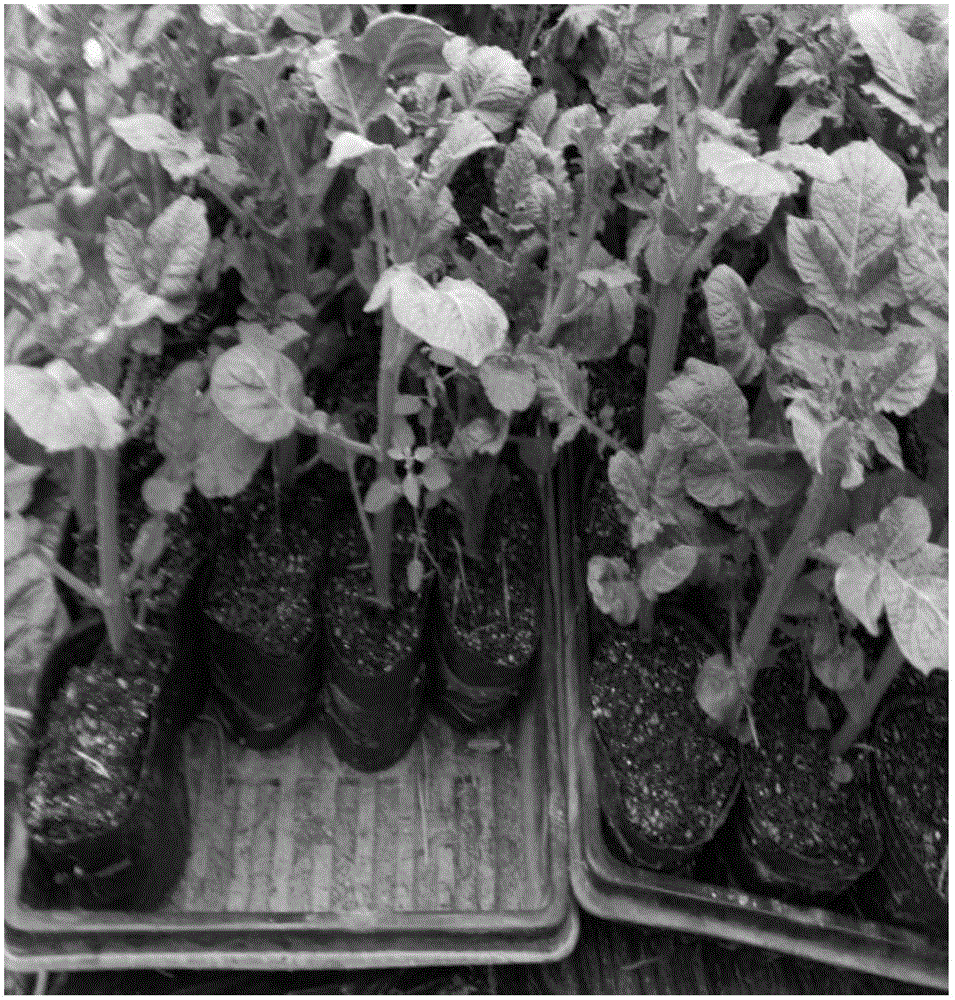Method for improving potato and tomato grafting survival rate
A survival rate, tomato technology, applied in the field of improving the survival rate of potato and tomato grafting, can solve the problems of complicated operation, incapable production, low grafting survival rate, etc., and achieve the effects of increasing tomato yield, promoting early flowering and fruiting, and prolonging the growth period
- Summary
- Abstract
- Description
- Claims
- Application Information
AI Technical Summary
Problems solved by technology
Method used
Image
Examples
Embodiment 1
[0093] Step 1, choose potatoes as rootstock, tomato as scion, and the scion grows seedlings 30 days earlier than rootstock,
[0094] Step 2: The stubble of potato rootstock seedlings is 10 cm high. Take 150 potato rootstock seedlings and divide them into three groups on average. The first group removes all shoots and leaves, the second group removes all shoots and leaves only half leaves, and the third group removes all shoots and leaves. Remove all shoots and leave one leaf;
[0095] Step 3, when the tomato scion seedling grows to 20-25cm, obliquely cut a 45° angle from the stem base of the seedling, get 150 tomato scion,
[0096] Step 4, the tomato scion is treated with the activation formula for 30mim, and then it can be grafted with the above three groups of potato rootstocks,
[0097] Step 5: Cross-cut the potato rootstock at 10 cm, cut vertically (90° angle) in the middle of the cut, insert the tomato scion into the cut of the potato rootstock, and then fix it with graf...
Embodiment 2
[0101] Step 1, choose potatoes as rootstock, tomato as scion, and the scion grows seedlings 30 days earlier than rootstock,
[0102] Step 2: The stubble of potato rootstock seedlings is 10 cm high. Take 150 potato rootstock seedlings and divide them into three groups on average. The first group removes all shoots and leaves, the second group removes all shoots and leaves only half leaves, and the third group removes all shoots and leaves. Remove all shoots and leave one leaf;
[0103] Step 3, when the tomato scion seedling grows to 20-25cm, obliquely cut a 45° angle from the stem base of the seedling, get 150 tomato scion,
[0104] Step 4, the tomato scion is treated with Fannuo formula for 30mim, and then it can be grafted with the above three groups of potato rootstocks,
[0105] Step 5: Cross-cut the potato rootstock at 10 cm, cut vertically (90° angle) in the middle of the cut, insert the tomato scion into the cut of the potato rootstock, and then fix it with grafting cli...
Embodiment 3
[0109] Step 1, choose potatoes as rootstock, tomato as scion, and the scion grows seedlings 30 days earlier than rootstock,
[0110] Step 2: The stubble of potato rootstock seedlings is 10 cm high. Take 150 potato rootstock seedlings and divide them into three groups on average. The first group removes all shoots and leaves, the second group removes all shoots and leaves only half leaves, and the third group removes all shoots and leaves. Remove all shoots and leave one leaf;
[0111] Step 3, when the tomato scion seedling grows to 20-25cm, obliquely cut a 45° angle from the stem base of the seedling, get 150 tomato scion,
[0112] Step 4, the tomato scion is directly grafted with the above-mentioned three groups of potato rootstocks,
[0113] Step 5: Cross-cut the potato rootstock at 10 cm, cut vertically (90° angle) in the middle of the cut, insert the tomato scion into the cut of the potato rootstock, and then fix it with grafting clips to complete the grafting.
[0114]S...
PUM
 Login to View More
Login to View More Abstract
Description
Claims
Application Information
 Login to View More
Login to View More - R&D
- Intellectual Property
- Life Sciences
- Materials
- Tech Scout
- Unparalleled Data Quality
- Higher Quality Content
- 60% Fewer Hallucinations
Browse by: Latest US Patents, China's latest patents, Technical Efficacy Thesaurus, Application Domain, Technology Topic, Popular Technical Reports.
© 2025 PatSnap. All rights reserved.Legal|Privacy policy|Modern Slavery Act Transparency Statement|Sitemap|About US| Contact US: help@patsnap.com



